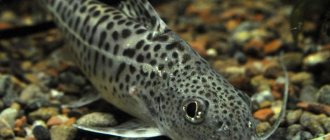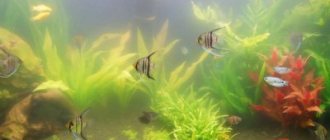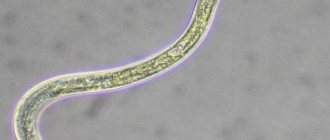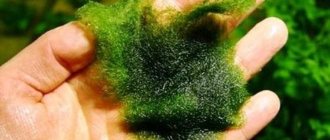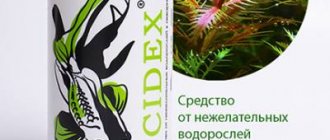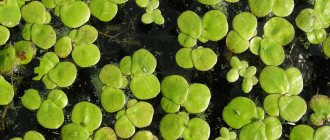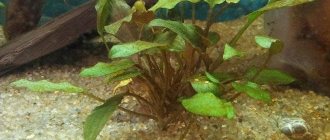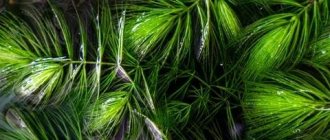Description
Catfish eat brown, green and red algae, including blackbeard. Otocinclus belongs to the family of chain-mailed (loricariid) catfishes. Popular along with the Siamese algae eater. The range extends to Venezuela, Brazil and Argentina. Otocinclus affinis live in flocks, in which the number of individuals can reach several hundred.
Appearance
This catfish was named chainmail due to the presence of protective bone plates. The body is elongated, slightly flattened on the sides. Reaches 3–5.5 cm in length. The back is dark, the plates are yellow-gray, and the belly is white. There are longitudinal dark stripes on the sides. The dorsal and pectoral fins are sharp and transparent. Mouth with suction cup, large eyes. There are differences in color between species.
Behavior
By nature, catfish are peaceful and shy. They are most active in the evening, but you can catch them cleaning glass and stones at any time. They are hardworking and quickly clear the aquarium of algae.
How long does a catfish live?
With good care, otocinclus lives 5–6 years.
Kinds
There are more than 17 known varieties of Otocinclus, which are sold under a common name. All species are suitable for keeping in an aquarium. The most common types:
- Otocinclus affinis or common (Otocinclus affinis). The color is yellowish, with a brown stripe on the sides. There are brown spots on the dark back. The fins are translucent with a green tint.
- Mottled. The color is olive and yellow, there is a pattern of short stripes on the body, and black spots on the back.
- Arnoldi. The species, strongly reminiscent of Otocinclus vulgaris, is distinguished by dark brown spots.
- Maria. It is less common on sale. Suitable for keeping in small containers, as it grows about 2 cm.
Feeding
Feeding your pet is not difficult; it takes care of itself, cleaning the aquarium from microscopic algae. If there is a large flock, additional feeding will be needed. Unlike others, Otocinclus is able to carefully eat away plaque not only from the walls and bottom of the tank, but even from the leaves of plants. His small teeth are incapable of harming them.
Experts use vegetables scalded with boiling water as food: lettuce, peas, cucumbers, zucchini. Uneaten remains are removed the next day so as not to poison the liquid. There are tablets for catfish on sale; they are used to expand the diet, although most often pets refuse this feeding, preferring live vegetation.
Driftwood serves not only as a decorative element; it collects bacterial mucus, which is very useful for Oto.
You can take any stone and place it in a well-lit place in a separate tank of water. In a few days it will have the green cover that Otiki love so much. Thus, by changing stones, they provide the catfish with food on an ongoing basis.
With good care and adequate nutrition, pets develop a paunch; this is normal and indicates health.
Quarantine before moving in
Before introducing them into the aquarium, place newly acquired fish in a quarantine container. Use a 30-liter aquarium without soil as a quarantine tank. If the disease is not detected within 3-4 weeks, place the otocinclus in a community aquarium. Water with a small peat content is suitable for quarantine. Add methylene blue solution for prevention. Do not add salt, solutions containing copper and insecticides to the water, as otocinclus does not tolerate these substances well.
View this post on Instagram
Posted by Moscow Aquarium Fish (@mosaquafish) Jan 16, 2019 at 2:41 PST
Aquarium
To maintain a group of 6 individuals, a 70 liter aquarium is sufficient. Select a rectangular-shaped container with a wide bottom. Place some shelters and snags.
Water parameters
| Water temperature | 21–27 degrees |
| Rigidity | 2–18 dGh |
| Acidity | 7–7.8 pH |
Requires high quality water with a low nitrate content (up to 10 mg per 1 liter of water), without nitrites. Change up to 30% of the water in the aquarium to fresh water weekly.
Plants
Plants serve as shelters. To comfortably keep Otocinclus catfish, plant a large number of plants:
- rotalu;
- Anubias;
- cryptocorynes;
- Echinodorus;
- ferns;
- mosses.
Priming
Select soil without sharp corners, fine and medium fractions. When containing dye in soil particles, ensure that the materials are non-toxic to fish.
Aeration and filtration
To keep catfish, select a powerful filter that passes through water in an amount of 3–5 aquarium volumes per hour. If the filter has a suction tube, protect the fish by covering the tube with a grill or mesh. High-quality aeration is also required.
Lighting
When arranging a lighting system, rely on the needs of the plants.
Feeding
The basis of the otocinclus diet is plant foods:
- flakes;
- seaweed;
- spirulina;
- zucchini;
- cucumbers;
- lettuce leaves;
- peas;
- spinach.
Boil vegetables for 1-2 minutes. before serving. Attach food to driftwood or rock. Remove leftover food no later than every other day. Otocinclus catfish quickly eat algae. To ensure they have enough food, take rocks and a couple of plant branches from the aquarium and place them in sunlight. Algae will appear in 2 weeks. Add protein foods to your diet:
- gammarus;
- bloodworm;
- tubifex;
- Artemia;
- daphnia.
Keeping Otocinclus affinis in the aquarium
Keeping fish is not difficult. Fish are schooling fish, it is better to keep them in a group. For a flock of Otocinclus affinis , an aquarium of 50 liters or more, densely planted with live plants, with many natural shelters, is suitable. The optimal temperature lies in the range from 21 to 27°C, pH 7.0 - 7.8. Hardness can vary widely, up to 20GH. A small flow of water is desirable. A weekly 30-50% water change is required. Bright light does not bother them, so the aquarium can be brightly lit, which is beneficial for aquatic plants and creates conditions for rapid growth of algae. High-quality biofiltration is required, the content of ammonium and nitrites is zero, and nitrates are less than 10 mg/l. In good conditions, fish practically do not get sick.
Otocinclus affinis
When water quality is poor, otocinclus quickly die as a result of massive bacterial damage.
Otocinclus often gather in places where water flows quickly. Therefore, it is necessary to have a grille on the filter suction tube.
Otocinclus, like other chain-mailed catfish, has spiny dorsal and pectoral fins, so when transplanting, you should use nets with a fine mesh and, having lowered the net into the water, you should turn it out so that the fish swims out of it.
It is not recommended to keep otocinclus with Siamese algae eaters, so as not to create food competition for them!
Otocinclus affinis is a peaceful creature. Easily gets along with all small and medium-sized, peaceful fish species.
Large cichlids may chase otocinclus, seeing them as potential prey.
It is believed that wild-caught otocinclus die in the aquarium within the first few weeks. To prevent this from happening, when adapting to keeping in an aquarium, you should follow certain rules. Firstly, do not immediately place fish in a large aquarium with plants (with a surface area of more than 1 square meter), but use a small aquarium (30-60 liters) without soil, with an established biological equilibrium, populated with simple fish (guppies, platies, etc.) .P.). Install two airlift sponge filters in it; this will provide good oxygen saturation of the water without creating a strong current. Otocinclus love to eat foam sponges, as well as the walls of the aquarium. The temperature should be maintained at 25-26°C.
About a dozen otocinclus can be planted in such an aquarium. At first, they should be fed spirulina tablets, such as Algae Wafers, and given some live bloodworms. This is necessary to restore the strength and health of the fish, since during transportation and storage in the store they most likely ate poorly or did not eat at all. Keeping them in such an aquarium for some time greatly increases their chances of survival.
The lifespan of otocinclus in an aquarium is about 5 years.
Otocinclus affinis
Reproduction
Breeding of otocinclus occurs in a general aquarium or spawning tank. Sometimes reproduction occurs without the knowledge of the aquarist.
How to distinguish a male from a female
The male has a slender abdomen. Females are more rounded and larger.
Getting offspring
Puberty occurs at 7 months of age. Before breeding, feed otocinclus with gammarus, bloodworms or tubifex, but do not forget about keeping algae in the aquarium. Breeders lay eggs several times a year. When kept in a group, the fish are divided into pairs, first arranging skirmishes between the males. Future parents clear a place for spawning.
To preserve the offspring, set up a spawning area. Comfortable conditions and water parameters:
| Volume | 30–60 l |
| Plants | mosses, anubias, cryptocorns in large quantities |
| Temperature | 20–23 degrees |
| Rigidity | 4–10 dGh |
| Acidity | 6.5–7 pH |
Place the spawners in the spawning tank. Spawning occurs in the morning. The fish lay their eggs among plants or stick them to the underside of leaves. During one spawning, otocinclus produce 60–130 eggs. After spawning, remove the fish and gradually increase the temperature to 26–28 degrees. Add a weak solution of methylene blue to the water to protect the eggs from fungal infections.
Fry
The fry hatch in 3–7 days. Addition of the antifungal solution can be stopped at this point. After 2–3 days, start feeding the fry:
- ciliates;
- algae;
- artemia;
- chopped egg yolk;
- microworm.
Change up to 30% of the water 1-2 times a week. When changing the water, put a fine mesh on the siphon or hose to prevent it from sucking in the fry. When keeping fry, the water height should be at least 5 cm. After a couple of weeks, the young individuals become colored and become similar to adult otocinclus.
Diet of Otocinclus affina
A significant part of the otocinclus diet consists of food of plant origin. They require large amounts of food. It is wrong to think that they can live only on “pasture”. Several individuals are able to clear a 300-liter aquarium of algae in 2-3 days, after which they begin to starve. Most often, they die precisely from lack of food in an aquarium devoid of algae.
There is information that otocinclus pursue discus and angelfish, eating mucus from their skin: they are probably attracted to various microorganisms living in the mucus.
If there is little algae in the aquarium, you should feed them blanched vegetables.
Zucchini is the best proven food. Blanched zucchini is given once a week. Before feeding it, you need to boil it for 2 minutes. The prepared food is placed on the bottom, or even better, on a snag, where the fish will quickly find it. Zucchini should not be left in the aquarium for more than two days.
It is believed that to maintain good shape, all chain-mailed catfish need driftwood, wood fibers and the microorganisms living in them possibly contribute to better digestion. If they neglect all types of food, then the algae available in the aquarium is enough for them.
Otocinclus are most active at night, so feeding should be done in the evening, before turning off the lights.
Diseases
Catfish are susceptible to poisoning in contaminated water. Monitor the level of harmful compounds and do not neglect water changes. If the fish stay near the surface of the water and breathe frequently, this indicates hypoxia - a lack of oxygen that occurs due to overcrowding, insufficient aeration and pollution. Parasitic diseases may appear, for example, gill flukes or ichthyophthyriosis (semolina). Diseases are treated with special drugs. All decorations and plants must be disinfected in a solution of potassium permanganate.
Reproduction of Otocinclus affinis in an aquarium
If keeping this fish is quite simple, then breeding is considered difficult and in an aquarium conditions occurs only sporadically. Sometimes Otocinclus affinis breeds in a community aquarium, unnoticed by its owner, especially if there are a lot of living plants in it. Which later becomes an obvious fact when grown-up juveniles are found in the aquarium.
Spawning usually occurs in the summer, without any water treatment. The stimulus for reproduction is frequent water changes and abundant fertilizing with protein foods - gammarus, bloodworms, tubifex and the presence of microorganisms in the water (Euglena viridis - “blooming water”).
The above-mentioned 30-60 liter aquarium without soil with a sponge filter is an ideal spawning ground for Otocinclus affinis . It is filled with fresh water at a temperature of 22°C, pH 7.0 - 7.8, dH - 6°. A significant number of plants with fairly large leaves are placed in it. A female and two or three males are placed for spawning. Spawning occurs every other day and lasts 5-6 hours, during which the males actively pursue the female throughout the aquarium. At a time, the female glues three to six eggs to the underside of the leaf. During spawning, from 50 to 100 eggs are laid. The caviar is sticky, transparent with a yellowish tint.
If fish have laid eggs on a plant in a community aquarium, you can cut off the leaves containing the eggs and place them in an incubator.
The water level in the incubator should be at least 5 cm. Temperature 24-26°C. Methylene blue is added to the water to make the water blue. Twice a day, 80% of the water should be replaced with fresh water, of the same composition, with the same amount of methylene blue.
Hatching occurs on the second day, after another two days the yolk sacs of the larvae dissolve, the fry begin to swim and actively feed. The starting food is Sera micron, or analogues, and frozen “live dust”. As they grow, the size of the feed increases.
Frequent changes of small amounts of water while simultaneously clearing the bottom of food residues help reduce the concentration of nitrates. When sucking out water with a siphon, it is necessary to put a fine-mesh mesh on the siphon so as not to suck in the fry along with the water. After the fry have swum, it’s a good idea to introduce small snails into the nursery aquarium - they will eat up excess food from the bottom, and their excrement serves as good food for ciliates.
It is a good idea to keep a separate container in sunlight so that water can bloom in it (these are numerous euglena and other single-celled organisms), which can also be used as starter food for fry.
By a month, the juveniles reach 1.5-2 cm, are completely colored and can be planted in a common aquarium with comparable fish. Otocinclus become sexually mature after 6 months.
I would like to hope that this fish will be noticed and Otocinclus affinis will take its rightful place in the aquariums of amateurs and professionals.
Photo gallery
Habitat
Originates from South America from the region near Rio de Janeiro (Brazil).
Inhabits small tributaries of larger rivers and floodplain lakes. Prefers regions with dense aquatic vegetation or herbaceous plants growing along the banks. Brief information:
- Aquarium volume - from 40 liters.
- Temperature - 20–26°C
- pH value – 6.0–8.0
- Water hardness - soft to medium hard (5–19 dGH)
- Substrate type - any
- Lighting - moderate
- Brackish water - no
- Water movement is weak
- The size of the fish is up to 5 cm.
- Diet: plant foods only
- Temperament - peaceful
- Living alone or in a group
- Life expectancy is about 5 years
Adviсe
- If Otocinclus affinis eats higher plants, this indicates a lack of greenery in the diet. In this case, keep a container in which algae and microorganisms will actively multiply under the influence of sunlight.
- When purchasing an otocinclus, pay attention to appearance and behavior. The fish should not be depressed, the body should be free of ulcers and white coating, and the fins should be intact.
- Treat new plants and soil before adding them to the aquarium. Soak the plants in a solution of potassium permanganate, methylene blue or hydrogen peroxide for 5–10 minutes. Rinse the plant thoroughly. Boil the soil.
- Avoid sudden changes in water temperature. Catfish do not survive sudden changes well.
- The fins of otocinclus are spiny, so carefully catch the fish with a net with a fine mesh.
Keeping algae-eating fish greatly reduces the amount of algae. But remember that fish are not always effective. If there is an algae outbreak in the tank, this indicates a failure in the aquarium's biosystem. Eliminate the cause of low vegetation, because an unknown biobalance is dangerous for all inhabitants of the reservoir.
Previous
FishSchubert's Barbus fish - not found in nature
Next
Fish6 species of catfish Gyrinocheilus
Behavior and Compatibility
Algae eaters are peaceful and inconspicuous fish. They do not cause disturbance to other inhabitants of the aquarium; they are protected from small predators by their cover. The shell may not protect against large ones (astronotus, parrots and other large cichlids), so such fish are not suitable as neighbors for catfish. Experienced aquarists advise avoiding proximity to those species whose sides are covered with protective mucus (angelfish, discus). Otocinclus, in an effort to clean everything around, often gets to this “raid”.
Peaceful fish like guppies, swordtails, gouramis and the like are ideal friends for otocinclus. General recommendation for compatibility: fish should not be territorial, large or aggressive.
A distinctive feature of otocinclus is their gregariousness. For comfortable living and reproduction, they need neighbors of their own species! A home aquarium contains at least 5-6 fish, the more the better.
Feeding/types of food:
we can say that it feeds itself, constantly eating algae. It has been noticed that over time, otocinclus begin to prefer the food provided by the owner and skimp on their responsibilities of cleaning the aquarium from algae. From time to time it is necessary to give small bloodworms. But fish cannot be left on a starvation diet. If there are no visible algae in the aquarium, you need to feed them either with specialized food or give them young zucchini, peas, spinach, etc.
